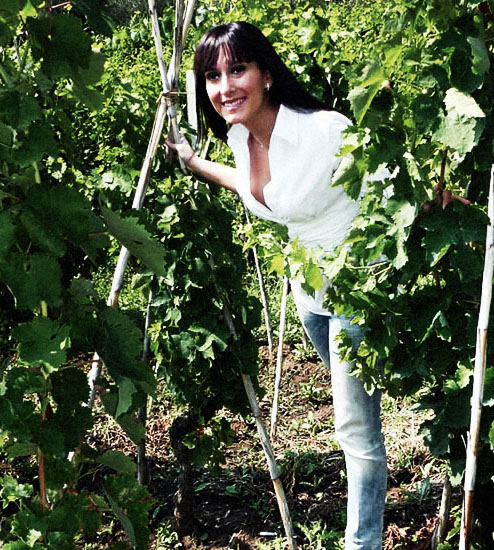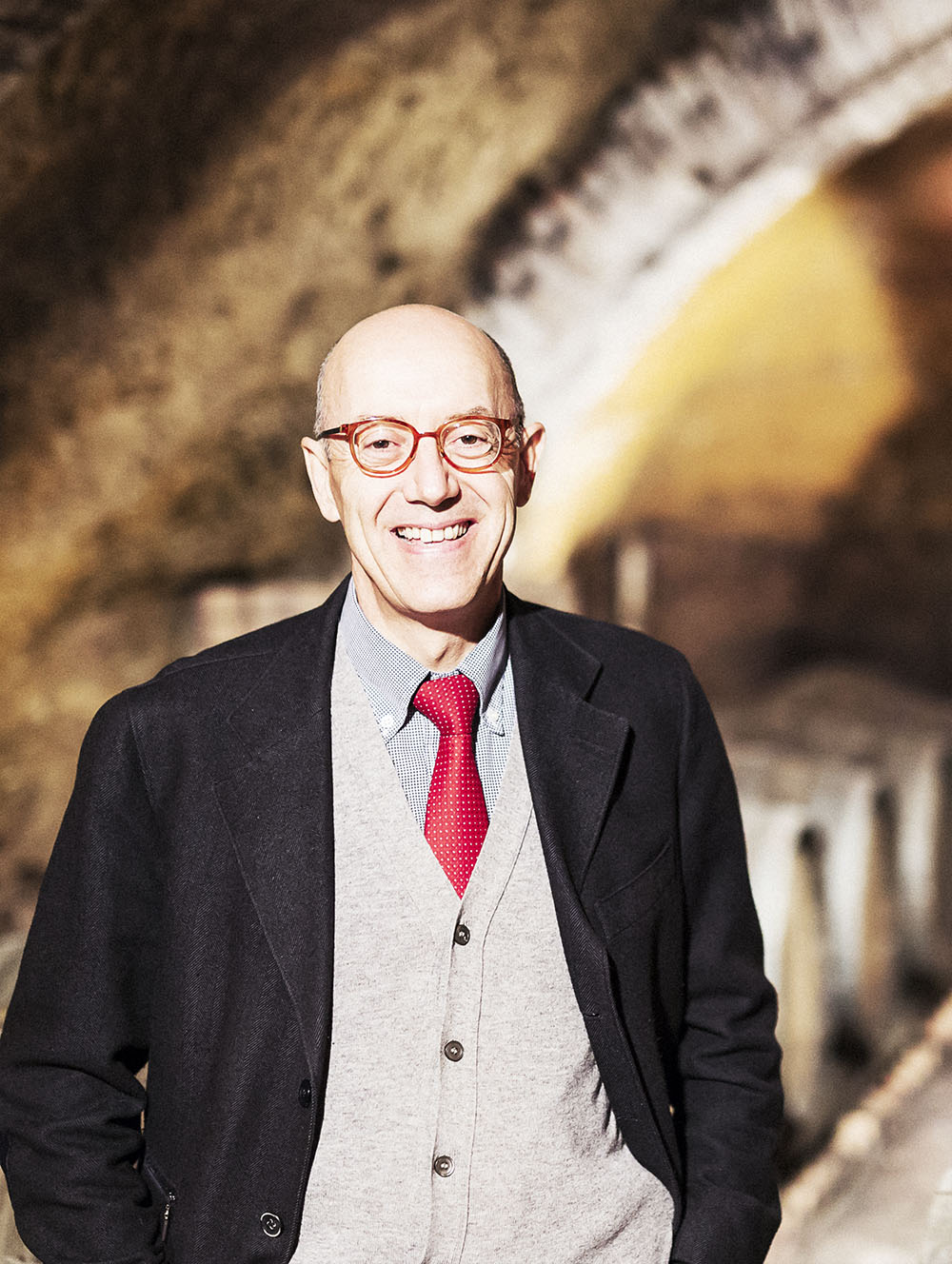“You cry twice when you come to Basilicata,” says Gerardo Giuratrabocchetti, proprietor of Cantine del Notaio. “Once because it is hard to get here. The second time because you are sad to leave.”
I was pretty close to having a meltdown by the time I arrived at my hotel in the town of Barile. I’d left Turin in Piedmont on an 8 am train and it was now close to 7 pm. Perhaps it was just hunger as I was quickly pacified by a feast of local specialties that included homemade salumi, broccoli rabe, sweet beans of Sarconi and roasted chestnuts. Ciamot, a scramble of eggs and sausage, seemed odd at dinnertime but made more and more sense with each delicious bite. And the cavatelli pasta, shaped like urled-up leaves, allowed each morsel to hold just the right amount of spicy tomato sauce. Crumbled on top were peperoni cruschi. These red peppers are dried then deep fried and taste better than any potato chip I’ve ever had. They earned second place for my favourite snack in the region. The aged Caciocavallo Podolico came in first. One of Italy’s most expensive cheeses, it is made from the raw milk of a rare breed of cow that grazes freely on flavour-imparting victuals like fennel, juniper and wild strawberries.
And of course, the Aglianico was flowing freely, which was the real premise of my visit. Along with Sangiovese and Nebbiolo, Aglianico is considered among Italy’s greatest red grapes. I fondly refer to it as Nebbiolo’s swarthy southern cousin. Let me be perfectly clear, the two are NOT actually related. However, similarly structured with copious, grippy tannins and plenty of acidity to match, both produce powerful, age-worthy wines. They are also capable of complex and haunting aromas that range from floral to savoury and tar-like. By contrast, Aglianico is deeper in colour and darker in flavour.
The greatest and most refined expressions of Aglianico hail from volcanic soil, which lends a smoky note and flinty minerality. In Campania, Basilicata’s western neighbour, the denomination of Taurasi is the reference while in Basilicata, Aglianico reaches its apogee in the area around Mount Vulture. Though relatively close in proximity, one is not an extension of the other and each boasts its own unique terroir and expression.
Giuratrabocchetti is my intrepid guide to Vulture. He looks more like a bird watcher than he does a winemaker. I’m sure he does watch birds in his spare time. He knows every aspect of the flora and fauna of the Vulture inside and out. Which is saying a lot for a region that counts approximately 8,600 different insect species alone.
He explains that not all volcanos are created — or erupt — equally. Vulture is an extinct volcano and, according to Giuratrabocchetti, the last eruption was 130,000 years ago. The main one was a massive explosion that blew the top off, reducing the volcano from 2,100 to just over 1,300 metres above sea level. As the lava cooled quickly, crystals had little time to form, resulting in a spongy tuffaceous soil. Prized for its ability to absorb water, this soil remains humid even during long dry spells, providing vines with necessary moisture. “Even in 2017, which was the hottest and summer in history, we did not need to irrigate,” declares Giuratrabocchetti.
This is important in Italy’s deep south. Yet Vulture isn’t as torrid as its latitude might suggest. As vineyards reach altitudes of 700 metres above sea level, it gets decidedly cold at night, even in the summer. Besides large diurnals swings, “the area also attracts strong winds,” continues Giuratrabocchetti. It is one of the last places in Italy to harvest. The long, slow ripening is necessary for Aglianico to reach full maturity and the resulting wines are intense and mineral-driven — and not for the faint of heart.
The area of Vulture is diverse and sprawling with a range of altitudes. Multiple eruptions have created stark differences in the soil: it’s pitch black in some areas; in other areas, there is white sand; and in others still, it’s ruddy red. The higher-altitude vineyards around the towns of Barile and Rapolla are pronounced in volcanic matter while those lower down, around Maschito and Venosa, have less but the latter is particularly iron rich. That said, it is not a case of one being better than the other. “One day we might talk about the communes of Vulture the same way we talk about the communes of Barolo,” suggests Ian D’Agata, an Italian wine authority and author of Native Wine Grapes of Italy.
First things first, what’s important is to simply spread the word of Vulture. Despite having such a captivating terroir, which hosts one of Italy’s finest reds, the region remains less known and less travelled. Producers have recognized the challenge and some have banded together to strengthen promotional efforts. Giuratrabocchetti is the ringleader of Qui Vulture, which translates as “here is Vulture” and assembles 11 producers representing the majority of the denomination’s production.


Another such group is Generation Vulture, an independent association of young, up-and-coming estates mostly small in size. Elena Fucci, one of the region’s top producers belongs to this group. She explains, “We all represent the next generation who have taken over family properties, creating our estates from nothing to safeguard the vineyards and our culture.”
While I can’t help but think that all would be better off if the two associations joined forces, but group promotion in general is a step in the right direction. And the future of Vulture hinges on the new generation at all its estates. This is a region where the young typically leave to seek their fortunes elsewhere. However, now they have an appreciation and passion for what is in their own backyard. “We are in love with Vulture, with Aglianico and this marvellous territory that has everything to discover,” says Fucci. The potential is palpable.
Faults like oxidation, volatile acidity and Brettanomyces still crop up but the region has been producing better and better wines. Besides more refined winemaking, many estates are questioning fashions of the past and being more thoughtful about how they use wood. At Terra dei Re, oenologist Leon Caparelli believes, “Botte gives a better balance of tannin whereas barrique imparts it unnecessarily.” As of 2017, the winery is transitioning to these larger format vessels for its Aglianico.
Other issues, namely the DOP regulations, remain a source of contention. A distinction is made between the Vulture DOC and the Vulture Superiore DOCG. While both stipulate 100 percent Aglianico, the former requires 10 months of aging versus three years for the latter, of which 12 months must be in barrel. There is even a Riserva level, which mandates five years of aging and a full 24 months in barrel. But does this mean better wine? Not necessarily. “The DOCG doesn’t help anything,” declares Donato D’Angelo, owner of the eponymous estate. And truly many of the best producers eschew it all together.
When I left Basilicata, I wasn’t quite reduced to tears. However, I had been so well fed and warmly welcomed that it felt like I was saying goodbye to family. There is no famous colosseum, romantic gondolas or leaning towers but there is an extinct volcano, pristine crater lakes, tasty food and fascinating wines. It will be impossible for me not to return.
Cantine del Notaio La Firma Aglianico del Vulture DOC 2012 ($45)
Giuratrabocchetti is actually a notary and the names of his wines refer to this profession. His different bottlings are crafted from Aglianico picked at different ripening times. La Firma means “signature” and represents the last grapes to be picked — in November. He has also switched from new barriques to older ones for aging. Macerated cherries and sweet violets with melted chocolate notes. The tannins are layered and mouth coating with Aglianico’s tell-tale firmness.
Cantina di Venosa Verbo Malvasia 2016, IGP Basilicata ($15)
This large, 350-member cooperative plays an important role in Vulture by providing a place for small growers to sell their grapes rather than abandoning their vineyards. It has also been instrumental in the revival of Malvasia Bianca di Basilicata, inspiring other producers to recover this rare grape. Lightly aromatic with lemon balm and peach aromas leading to a fleshy pear-laden, honey-tinged palate.
Paternoster Don Anselmo Aglianico del Vulture DOC 1998 ($45)
Paternoster is a well-known estate in Basilicata and has long been associated with the region’s best wine. In 2016, it was sold to the Tommasi family of Amarone fame. It was a treat to try this Aglianico as it approaches its third decade. Tobacco, sous bois and cinnamon with mellowed tannins that have not dried out.
Elena Fucci Titolo Aglianico del Vulture DOC 2015 ($40)
Intensely mineral and still very young, this excellent Aglianico needs time for all of its sweet and savoury elements, like black liquorice, wild berries and lavender, to knit together. Assertive and commanding.
Tenuta i Gelsi Aglianico DOC 2012, IGP Basilicata ($20)
Made in stainless steel and aged for less time than the DOC requires, this is a charmingly fresh example of Aglianico with fennel, fragrant florals and a juicy core.
Terra dei Re Vulcano 800 Pinot Nero 2016, IGP Basilicata ($35)
A complete surprise made from Pinot Noir grown at 800 metres above sea level. Apparently, Pinot was planted in Vulture in the 18th century but disappeared in favour of more deeply coloured varieties. Fresh, bright and clean, it demonstrates lovely mountain herb and black raspberry nuances with fine-grained tannins.
Donato D’Angelo Aglianico del Vulture DOC 2012 ($25)
Donato D’Angelo is one of the references in the Vulture and the Aglianico is top notch. Restrained aromas of rose, red cherry, iron and spice reveal themselves slowly. The palate is polished and sophisticated without lacking character. An elegant Aglianico that will age gracefully.
